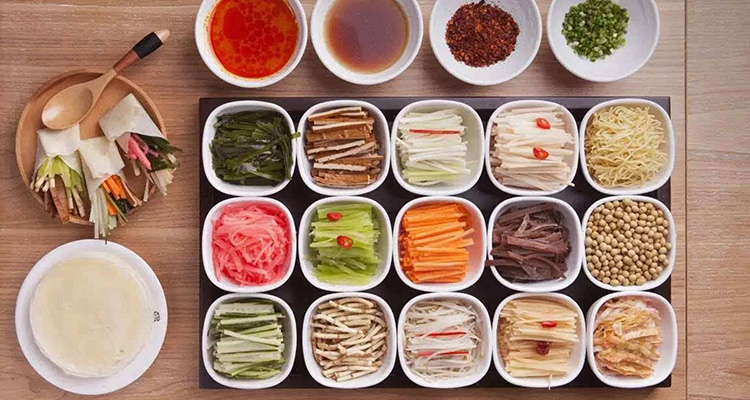Guiyang Siwawa – DIY Vegetable Wraps with Tangy Soup from Guizhou Street Food
When a table full of colorful shredded vegetables spreads out like an artist’s palette, and paper-thin wrappers are neatly stacked beside them, you know something fun is about to begin. This is Siwawa, also known as Guiyang Rice Wrap Assortment — a dish where you create your own bite-sized art. Take a delicate wrapper in your palm, add your choice of shredded vegetables, fold it gently like wrapping a baby, and pour a spoonful of tangy sour soup over the top. One bite, and the fresh, sour-spicy flavor bursts on your tongue — it feels like tasting the freshness of Guizhou’s mountains in one mouthful.
1. Origin and History
Siwawa originated on the streets of Guiyang over a hundred years ago. It began as a humble meal created by poor families using leftover vegetables and cheap dough wrappers. Because the small wraps resembled a swaddled baby, locals nicknamed them “Siwawa,” meaning “silk baby.” Over time, it evolved into one of Guiyang’s most iconic street foods — a true reflection of local wisdom and culinary creativity.
2. Cultural Significance
In Guiyang, eating Siwawa is more than just a meal — it’s a social experience. Friends and family gather around a table, wrapping and chatting as they eat, creating a lively and joyful scene. This snack reflects the Guiyang spirit: practical, inventive, and full of zest for life. Today, it’s one of the most popular foods among young people and a must-try for visitors.

3. Ingredients and Features
The rice wrapper must be thin as paper yet flexible, usually about 8 centimeters in diameter. Common fillings include shredded cucumber, radish, bean sprouts, kelp strips, and houttuynia cordata (fish mint). The heart of the dish lies in the sour soup, made from tomatoes, chili, and other ingredients to create a refreshing, tangy base. Dipping sauces are also essential — from mildly sour to intensely spicy — adding layers of flavor to every bite.
4. Preparation Process
First, wash and shred the vegetables, arranging each in separate dishes. Steam the rice wrappers until soft and keep them warm. To eat, lay a wrapper flat, add your choice of vegetables, fold the bottom first, then both sides toward the center, leaving the top open. Before eating, pour in the sour soup or dipping sauce through the opening. The whole process is fun, hands-on, and perfect for sharing.

5. Flavor and Texture
Each bite of Siwawa offers a blend of textures and tastes — the wrapper is soft yet slightly chewy, the vegetables are crisp and refreshing, and the sour-spicy soup ties it all together. The first taste is mild and tender, then comes the crunch of vegetables, followed by the bright tang of chili and vinegar — clean, layered, and utterly addictive.
6. How to Eat
The most authentic way to enjoy Siwawa is to hold the wrap with your left hand and use a spoon in your right to pour soup from the top before eating it whole. Locals often pair it with a bowl of mung bean soup, using the sweet flavor to balance the sour and spicy taste. Wrapping skills matter — it should be tight enough to hold, yet loose enough to allow space for the soup.

7. Where to Try
For the best Siwawa in Guiyang, visit Aunt Yang’s Siwawa (杨阿姨丝娃娃) (average ¥25–40 per person) or Si Lian Hong Tang Siwawa (丝恋红汤丝娃娃) (around ¥30–50 per person). Go in the evening for the most lively atmosphere. Order a “set meal,” which includes wrappers and a variety of vegetables — refills are usually free!
8. Travel Tips for Visitors
In English, Siwawa is often translated as Guiyang Rice Wrap Assortment. If it’s your first time, don’t worry if your wraps look messy — you can ask the staff for a quick demo. If you’re sensitive to spice, choose the mild or tomato-based sour soup. Be sure to eat while it’s hot — once cooled, the wrappers lose their softness and the texture changes.

9. Easy Home Version
At home, you can use spring roll wrappers or wonton wrappers as substitutes. Pick easy-to-prepare vegetables like cucumber and carrot. For a simple dipping sauce, mix rice vinegar, a bit of sugar, and chili oil. While it may not match the restaurant version, it’s still a fun and interactive dish — perfect for family gatherings or weekend meals.
Join this delightful finger-food feast and experience Guiyang’s creativity firsthand! As you wrap the colorful vegetables and taste the zesty soup, you’ll understand why Siwawa has captured the hearts of locals. In this mountain city famed for its food, few dishes represent Guiyang’s charm and vitality better than making your own Siwawa!


